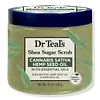What's inside
What's inside
 Key Ingredients
Key Ingredients

 Benefits
Benefits

 Concerns
Concerns

 Ingredients Side-by-side
Ingredients Side-by-side

Sucrose
HumectantGlycerin
HumectantSorbitol
HumectantWater
Skin ConditioningPolysorbate 20
EmulsifyingSilica
AbrasiveParfum
MaskingCitrus Aurantium Bergamia Fruit Oil
MaskingJuniperus Mexicana Oil
MaskingCitrus Aurantium Dulcis Peel Oil
MaskingButyrospermum Parkii Butter
Skin ConditioningCannabis Sativa Seed Oil
EmollientPersea Gratissima Oil
Skin ConditioningCitrus Sinensis Peel Oil Expressed
PerfumingOenothera Biennis Oil
EmollientMacadamia Ternifolia Seed Oil
EmollientPrunus Amygdalus Dulcis Oil
Skin ConditioningCarthamus Tinctorius Seed Oil
MaskingCocos Nucifera Oil
MaskingRetinyl Palmitate
Skin ConditioningAscorbic Acid
AntioxidantSorbic Acid
PreservativePhenoxyethanol
PreservativeEthylhexylglycerin
Skin ConditioningCI 19140
Cosmetic ColorantCI 42090
Cosmetic ColorantCI 17200
Cosmetic ColorantSucrose, Glycerin, Sorbitol, Water, Polysorbate 20, Silica, Parfum, Citrus Aurantium Bergamia Fruit Oil, Juniperus Mexicana Oil, Citrus Aurantium Dulcis Peel Oil, Butyrospermum Parkii Butter, Cannabis Sativa Seed Oil, Persea Gratissima Oil, Citrus Sinensis Peel Oil Expressed, Oenothera Biennis Oil, Macadamia Ternifolia Seed Oil, Prunus Amygdalus Dulcis Oil, Carthamus Tinctorius Seed Oil, Cocos Nucifera Oil, Retinyl Palmitate, Ascorbic Acid, Sorbic Acid, Phenoxyethanol, Ethylhexylglycerin, CI 19140, CI 42090, CI 17200
Pumice
AbrasiveWater
Skin ConditioningGlycolic Acid
BufferingSodium Cocoyl Isethionate
CleansingLactic Acid
BufferingDimethicone
EmollientStearic Acid
CleansingCetearyl Alcohol
EmollientSodium Hydroxide
BufferingPalmitic Acid
EmollientGlycerin
HumectantC12-15 Alkyl Benzoate
AntimicrobialSorbitol
HumectantColloidal Oatmeal
AbsorbentTocopherol
AntioxidantChrysanthemum Parthenium Extract
Skin ConditioningCamellia Sinensis Leaf Extract
AntimicrobialGlycyrrhiza Glabra Root Extract
BleachingSalix Nigra Bark Extract
Skin ProtectingBisabolol
MaskingHydrogenated Coconut Acid
EmollientXanthan Gum
EmulsifyingSteareth-20
CleansingSteareth-21
CleansingMyristic Acid
CleansingSodium Isethionate
CleansingPhenoxyethanol
PreservativePotassium Sorbate
PreservativeSodium Benzoate
MaskingLeuconostoc/Radish Root Ferment Filtrate
AntimicrobialEDTA
Pumice, Water, Glycolic Acid, Sodium Cocoyl Isethionate, Lactic Acid, Dimethicone, Stearic Acid, Cetearyl Alcohol, Sodium Hydroxide, Palmitic Acid, Glycerin, C12-15 Alkyl Benzoate, Sorbitol, Colloidal Oatmeal, Tocopherol, Chrysanthemum Parthenium Extract, Camellia Sinensis Leaf Extract, Glycyrrhiza Glabra Root Extract, Salix Nigra Bark Extract, Bisabolol, Hydrogenated Coconut Acid, Xanthan Gum, Steareth-20, Steareth-21, Myristic Acid, Sodium Isethionate, Phenoxyethanol, Potassium Sorbate, Sodium Benzoate, Leuconostoc/Radish Root Ferment Filtrate, EDTA
 Reviews
Reviews

Ingredients Explained
These ingredients are found in both products.
Ingredients higher up in an ingredient list are typically present in a larger amount.
Glycerin is already naturally found in your skin. It helps moisturize and protect your skin.
A study from 2016 found glycerin to be more effective as a humectant than AHAs and hyaluronic acid.
As a humectant, it helps the skin stay hydrated by pulling moisture to your skin. The low molecular weight of glycerin allows it to pull moisture into the deeper layers of your skin.
Hydrated skin improves your skin barrier; Your skin barrier helps protect against irritants and bacteria.
Glycerin has also been found to have antimicrobial and antiviral properties. Due to these properties, glycerin is often used in wound and burn treatments.
In cosmetics, glycerin is usually derived from plants such as soybean or palm. However, it can also be sourced from animals, such as tallow or animal fat.
This ingredient is organic, colorless, odorless, and non-toxic.
Glycerin is the name for this ingredient in American English. British English uses Glycerol/Glycerine.
Learn more about GlycerinPhenoxyethanol is a preservative that has germicide, antimicrobial, and aromatic properties. Studies show that phenoxyethanol can prevent microbial growth. By itself, it has a scent that is similar to that of a rose.
It's often used in formulations along with Caprylyl Glycol to preserve the shelf life of products.
Sorbitol is a sugar alcohol. It is a hydrating and moisturizing agent created from the reduction process of glucose.
Most sorbitol is usually made from potato starch. It is also found in fruits such as apples and pears.
As a humectant, Sorbitol helps draw water to the skin. This helps keep the skin hydrated. Sorbitol also helps create a thicker texture in products. You might find sorbitol in your toothpaste and other gels.
It is a non-irritating ingredient that is great for those with dry skin.
Sorbitol is a prebiotic. It helps promote the growth of healthy bacteria on your skin. The bacteria on your skin form a microbiome. This microbiome helps protect your skin from infection and harmful bacteria.
Learn more about SorbitolWater. It's the most common cosmetic ingredient of all. You'll usually see it at the top of ingredient lists, meaning that it makes up the largest part of the product.
So why is it so popular? Water most often acts as a solvent - this means that it helps dissolve other ingredients into the formulation.
You'll also recognize water as that liquid we all need to stay alive. If you see this, drink a glass of water. Stay hydrated!
Learn more about Water